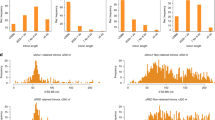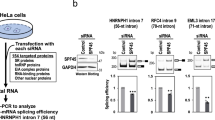Abstract
Introns are defined by sequences that bind components of the splicing machinery. The branchpoint consensus, polypyrimidine (poly(Y)) tract, and AG at the splice boundary comprise the mammalian 3′ splice site1. Although the AG is crucial for the recognition of introns with relatively short poly(Y) tracts, which are termed ‘AG-dependent introns’2, the molecule responsible for AG recognition has never been identified. A key player in 3′ splice site definition is the essential heterodimeric splicing factor U2AF, which facilitates the interaction of the U2 small nuclear ribonucleoprotein particle with the branch point. The U2AF subunit with a relative molecular mass (Mr 65K) of 65,000 (U2AF65) binds to the poly(Y) tract3,4,5,6,7, whereas the role of the 35K subunit (U2AF35)8 has not been clearly defined. It is not required for splicing in vitro4 but it plays a critical role in vivo9,10. Caenorhabiditis elegans introns have a highly conserved U4CAG/R at their 3′ splice sites instead of branch-point and poly(Y) consensus sequences11. Nevertheless, C. elegans has U2AF (refs 10, 12). Here we show that both U2AF subunits crosslink to the 3′ splice site. Our results suggest that the U2AF65–U2AF35 complex identifies the U4CAG/R, with U2AF35 being responsible for recognition of the canonical AG.
This is a preview of subscription content, access via your institution
Access options
Subscribe to this journal
Receive 51 print issues and online access
$199.00 per year
only $3.90 per issue
Buy this article
- Purchase on Springer Link
- Instant access to full article PDF
Prices may be subject to local taxes which are calculated during checkout



Similar content being viewed by others
References
Moore,M. J., Query,C. C. & Sharp,P. A. in The RNA world (eds Gesteland, R. F. & Atkins, J. F.) 303–357 (Cold Spring Harbor Laboratory Press, Cold Spring Harbor, NY, 1993).
Reed,R. The organization of 3′ splice-site sequences in mammalian introns. Genes Dev. 3, 2113–2123 (1989).
Ruskin,B., Zamore,P. D. & Green,M. A factor, U2AF, is required for U2 snRNP binding and splicing complex assembly. Cell 52, 201–219 (1988).
Zamore,P. D. & Green,M. R. Biochemical characterization of U2 snRNP auxiliary factor: an essential pre-mRNA splicing factor with a novel intranuclear distribution. EMBO J. 10, 210–214 (1991).
Zamore,P. D. & Green,M. Identification, purification and biochemical characterization of U2 small nuclear ribonucleoprotein auxiliary factor. Proc. Natl Acad. Sci. USA 86, 9243–9247 (1989).
Zamore,P. D., Patton,J. G. & Green,M. Cloning and domain structure of the mammalian splicing factor U2AF. Nature 355, 609–614 (1992).
Valcarcel,J., Gaur,R. K., Singh,R. & Green,M. R. Interaction of U2AF65 RS region with pre-mRNA branch point and promotion of base pairing with U2 snRNA. Science 273, 1706–1709 (1996).
Zhang,M., Zamore,P. D., Carmo-Fonseca,M., Lamond,A. I. & Green,M. R. Cloning and intracellular localization of the U2 small ribonucleoprotein auxiliary factor small subunit. Proc. Natl Acad. Sci. USA 89, 8769–8773 (1992).
Rudner,D. Z., Kanaar,R., Breger,K. S. & Rio,D. C. Mutations in the small subunit of the Drosophila U2AF splicing factor cause lethality and developmental defects. Proc. Natl Acad. Sci. USA 93, 10333–10337 (1996).
Zorio,D. A. R. & Blumenthal,T. U2AF35 is encoded by an essential gene clustered in an operon with RRM/cyclophilin in C. elegans. RNA 5, 487–494 (1999).
Blumenthal,T. & Steward,K. in C. elegans II (eds Riddle, D., Blumenthal, T., Meyer, B. & Priess, J.) 117–145 (Cold Spring Harbor Laboratory Press, Cold Spring Harbor, NY, 1997).
Zorio,D. A. R., Lea,K. & Blumenthal,T. Cloning of Caenorhabditis U2AF65: an alternative spliced RNA containing a novel exon. Mol. Cell. Biol. 17, 946–953 (1997).
Rudner,D. Z., Breger,K. S., Kanaar,R., Adams,M. D. & Rio,D. C. RNA binding activity of heterodimeric splicing factor U2AF: at least one RS domain is required for high affinity binding. Mol. Cell. Biol. 18, 4004–4011 (1998).
Conrad,R., Liou,R. F. & Blumenthal,T. Functional analysis of a C. elegans trans-splice acceptor. Nucleic Acids Res. 21, 913–919 (1993).
Zhang,H.-B. & Blumenthal,T. Functional analysis of an intron 3′ splice site in Caenorhabditis elegans. RNA 2, 380–388 (1996).
Jones,D., Russnak,R. H., Kay,R. J. & Candido,E. P. Structure, expression, and evolution of a heat shock gene locus in Caenorhabditis elegans that is flanked by repetitive elements. J. Biol. Chem. 261, 2006–2015 (1986).
Liou,R.-F. & Blumenthal,T. Trans-spliced Caenorhabditis elegans mRNAs retain trimethylguanosine caps. Mol. Cell. Biol. 10, 1764–1768 (1990).
MacMorris,M. A., Zorio,D. A. R. & Blumenthal,T. An exon that prevents transport of a mature mRNA. Proc. Natl Acad. Sci. USA 96, 3813–3818 (1999).
Stroeher,V. L. et al. DNA–protein interactions in the Caenorhabditis elegans embryo: oocyte and embryonic factors that bind to the promoter of the gut-specific ges-1 gene. Dev. Biol. 163, 367–380 (1994).
Wilusz,J. & Shenk,T. A 64 kd nuclear protein binds to RNA segments that include the AAUAAA polyadenylation motif. Cell 52, 221–228 (1988).
Acknowledgements
We thank M. Green and T. Nilsen for sharing results before publication; I. Perez for helpful discussions; and M. MacMorris, A. Deshpande, D. Evans and D. Bentley for critical reading of the manuscript. This research was supported by the National Institute of General Medical Sciences.
Author information
Authors and Affiliations
Corresponding author
Rights and permissions
About this article
Cite this article
Zorio, D., Blumenthal, T. Both subunits of U2AF recognize the 3′ splice site in Caenorhabditis elegans. Nature 402, 835–838 (1999). https://doi.org/10.1038/45597
Received:
Accepted:
Issue Date:
DOI: https://doi.org/10.1038/45597
This article is cited by
-
Functional significance of U2AF1 S34F mutations in lung adenocarcinomas
Nature Communications (2019)
-
Allele-specific binding of RNA-binding proteins reveals functional genetic variants in the RNA
Nature Communications (2019)
-
Deep intronic mutations and human disease
Human Genetics (2017)
-
An extended U2AF65–RNA-binding domain recognizes the 3′ splice site signal
Nature Communications (2016)
-
Diverse regulation of 3′ splice site usage
Cellular and Molecular Life Sciences (2015)
Comments
By submitting a comment you agree to abide by our Terms and Community Guidelines. If you find something abusive or that does not comply with our terms or guidelines please flag it as inappropriate.



